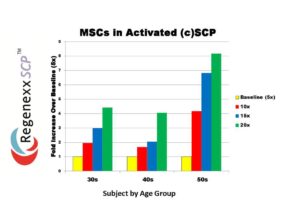Platelet Rich Plasma-Can you get a Better Result through Higher Platelet Concentration?
While there are many different treatment protocols and a lack of standardisation that exists in the preparation of platelet-rich plasma (PRP), it is important to keep in mind that not all PRP is created equal.
The goal of all PRP is to stimulate the damaged/degenerative region’s natural cells toward repair. Platelet concentration is directly proportional to growth factor concentration. When more platelets are isolated in a PRP preparation, more growth factors are delivered to the application site. These growth factors support several key processes, including stem cell recruitment, angiogenesis, cell proliferation and differentiation – all contributing to cellular regeneration.

Figure 1: Courtesy Regenexx-SCP
Figure 1. demonstrates how stem cells responded when stimulated by platelets from different age groups, as the amount of growth factors in platelets declines with age.
For all patient groups (patients in their 30’s, 40’s, and 50’s), a higher concentration of platelet rich plasma stimulates more stem cell growth.
Note differences in the amount of stimulation between 5, 10, 15, and 20X for the “50’s” patients. Concentrating in this age group makes a difference. What we are possibly seeing is that there’s a saturation point. This means that when you’re young, you have an abundant amount of growth factors in your platelets, so at some point concentrating them beyond a physiologic limit is a point where the cells are unable to generate a further therapeutic process, referred to as a saturation point.
Regarding growth factors there are two parts to the equation. On the one side you have the amount of growth factors coming from platelets, while on the other there are receptors that these growth factors stimulate on the damaged tissue or local MCS’s. The body frequently adjusts the number of receptors based on a feedback mechanism on cells, up or down, based on what’s available to trigger those receptors. Having less growth factors circulating around them, older stem cells may express more receptors for these platelet growth factors on their surfaces. Having more receptors means they can respond better to less stimulus coming from older and growth factor depleted platelets. Flooding these older cells with lots of platelet growth factors may therefore give an even better proliferation response, as there are more receptors for the GFs to stimulate.
So, concentrating PRP to high levels in older patients is likely well worth the effort. So if you’re middle aged, you may want to take advantage of this additional concentration to maximally stimulate the regenerative process to its full potential.